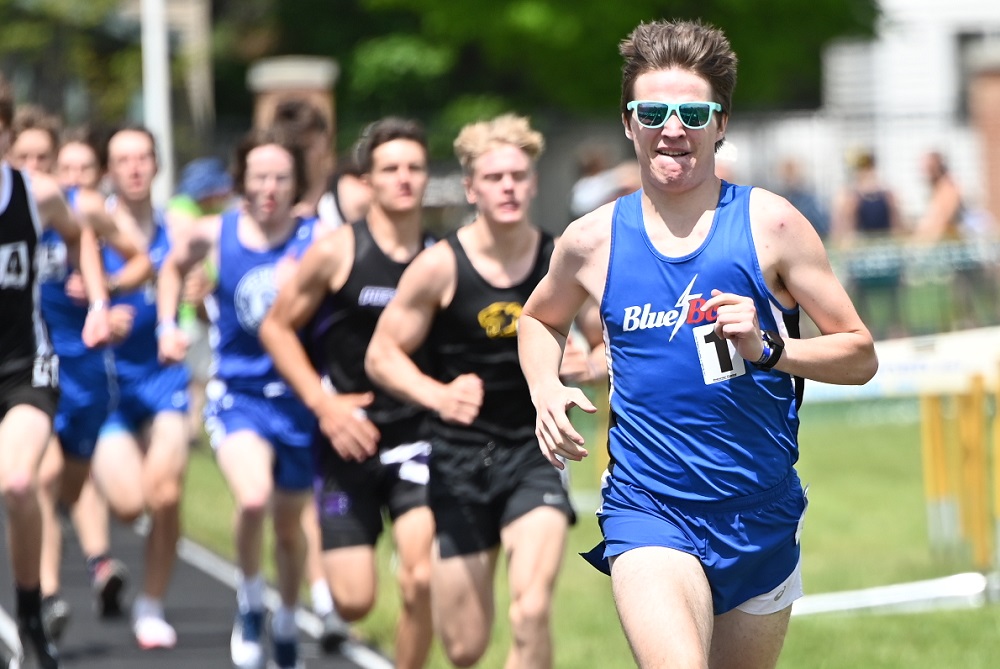
Copper Country Distance Stars Cap Senior Seasons with Fast Finals Finishes
By
John Vrancic
Special for MHSAA.com
June 13, 2022
CALUMET — It was quite a workout for Dollar Bay’s Nik Thomas and Houghton’s Eric Weiss whenever they met in area track meets this season.
 A prime example was on display during the Houghton County Invitational on May 13 at Houghton when both seniors were clocked under 10 minutes in the 3,200-meter run.
A prime example was on display during the Houghton County Invitational on May 13 at Houghton when both seniors were clocked under 10 minutes in the 3,200-meter run.
Thomas won in a school-record 9:54.91, and Weiss was runner-up at 9:56.47.
Thomas also set a school record at that time in the 1,600 while winning in 4:26.58. Weiss was clocked at a personal-best 4:30.71.
“Breaking 10 minutes in the 3,200 was a huge accomplishment.” Thomas said after winning four races in the Division 3 Regional at Lake Linden on May 18. “I was really proud of that. Kolson Kytta (last year’s UPD3 1,600 and 3,200 champ and now assistant track coach at Chassell) called out my splits at Houghton, and I really appreciate that. What’s neat is every time I ran a PR, I set a school record.”
Thomas then established Upper Peninsula D3 Finals records June 4 in the 1,600 (4:25.91) – which topped his previous school record – and 3,200 (10:05.59).
He also won the 800 (2:01.27) at the U.P. Finals in Kingsford.
Weiss was Division 1 runner-up in the 800 (2:03.18) and 3,200 (10:07.12) and third in the 1,600 (4:37.2) at the Finals.
Thomas also set the school record in the 800 (1:59.92) in the Copper Country Invitational in Houghton on May 16 and added three victories in the Copper Mountain Conference meet at Wakefield on May 24.
“Nik is crazy fast,” said Weiss, who won the 3,200 in a personal-best 9:49 at the Ontonagon Invitational May 6. “I was very happy with running a 4:30 in the Houghton County Invitational. That was also a great race when I got my PR at Ontonagon. I definitely felt good that day.”
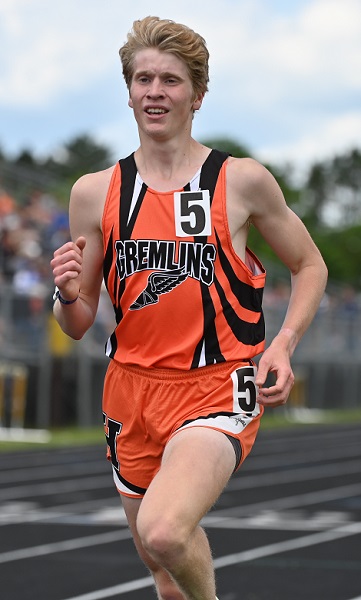 Also in the mix was Ewen-Trout Creek senior Jonah Nordine, who was the UPD3 Finals runner-up in the 800 (2:06.39), 1,600 (4:40.3) and 3,200 (10:26.51).
Also in the mix was Ewen-Trout Creek senior Jonah Nordine, who was the UPD3 Finals runner-up in the 800 (2:06.39), 1,600 (4:40.3) and 3,200 (10:26.51).
Weiss, who took the Western Peninsula Athletic Conference title in the 1,600 (4:37.44) and 3,200 (10:21.03) on May 31 at Calumet, became interested in distance running as a freshman.
“I went out for cross country and started enjoying it,” said Weiss, who plans to continue his running career this fall at North Dakota State University in Grand Forks. “I’ve also done cross country skiing and a little bit of running in the winter.”
Thomas, who temporarily battled paralysis during his sophomore year, says he was proud to represent his school.
“I got into such a zone,” said Thomas, who also set two meet records in the Houghton County and Copper Country Invitationals. “There were times when I lost my vision. While I was paralyzed I never thought this would be possible, but everybody was so supportive.
“Going under two minutes in the 800 was unbelievable. We’re such a small school. Everybody knows everybody. I don’t think you’ll find this kind of experience anywhere else.”
 John Vrancic has covered high school sports in the Upper Peninsula since joining the Escanaba Daily Press staff in 1985. He is known most prominently across the peninsula for his extensive coverage of cross country and track & field that frequently appears in newspapers from the Wisconsin border to Lake Huron. He received the James Trethewey Award for Distinguished Service in 2015 from the Upper Peninsula Sportswriters and Sportscasters Association.
John Vrancic has covered high school sports in the Upper Peninsula since joining the Escanaba Daily Press staff in 1985. He is known most prominently across the peninsula for his extensive coverage of cross country and track & field that frequently appears in newspapers from the Wisconsin border to Lake Huron. He received the James Trethewey Award for Distinguished Service in 2015 from the Upper Peninsula Sportswriters and Sportscasters Association.
PHOTOS (Top) Dollar Bay’s Nik Thomas leads the pack near the end of the first lap of the UPD3 800 race at the June 4 Finals at Kingsford. (Middle) Houghton's Eric Weiss runs a straightaway during the UPD1 3,200 championship race. (Photos by Cara Kamps/Run Michigan.)
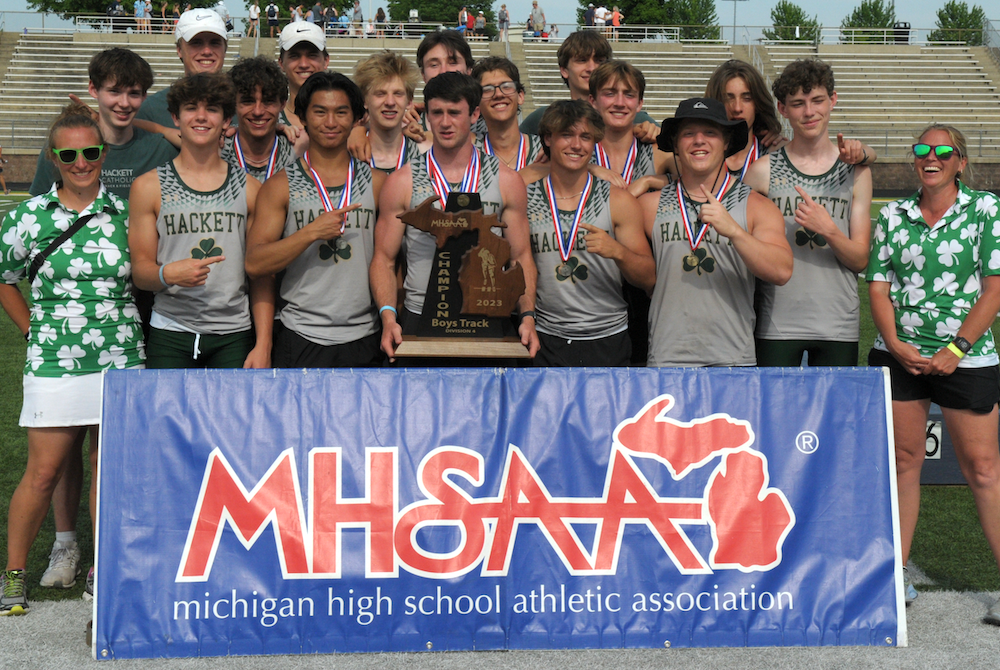
Thrower Claims Lone Individual Title to Lead Hackett to Team 3-Peat
By
Tom Lang
Special for MHSAA.com
June 3, 2023
Kalamazoo Hackett Catholic Prep just keeps winning and winning.
This time the Irish took home their fourth title in the last five Lower Peninsula Division 4 Track & Field Finals, on Saturday at Hudsonville.
Hackett’s only individual title was taken by discus winner Nathan Buchmann, a senior, who was fine knowing he was the shortest in stature among all the sizable competitors.
“In the offseason after football I worked out every day, working towards this goal,” he said after getting his medal. “I would say this takes 80 percent technique and 20 percent strength to throw the discus. So, length can help but if you have good technique and are really strong, that will play into it.
“I think we are very balanced throughout the meet today,” he said about teammates that scored points in finishes other than first place. “We have 13 guys here today, and we have people in a lot of the races. But I do not run; I have too short of legs to be a fast runner,” he said with a chuckle.
Buchmann had to work through a hip injury to compete this spring.
“I think the setbacks are what make you strong,” he said. “You can either give up through the setbacks or push forward and become better.”
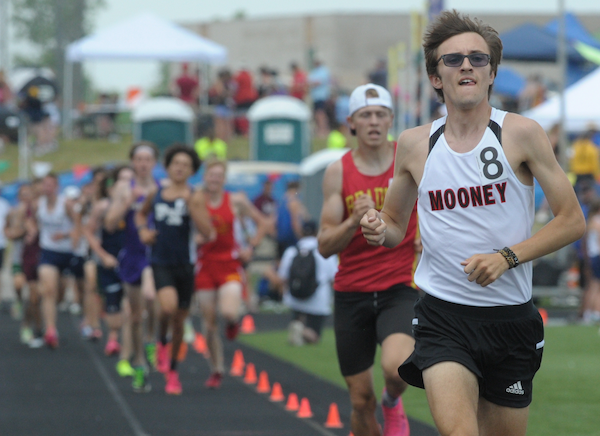 Coach Charissa Dean agreed.
Coach Charissa Dean agreed.
“The kids have big hearts,” she said after all the points were totaled and the Irish were on top once again, with 53. “They worked hard. They had a lot of potential when we started the season. And we had a lot of drive to put in the work, and we are happy the results came out the way they did.”
Reading was runner-up at 47 points, followed by Wyoming Potter’s House Christian with 42, then Fowler and Flint Beecher each with 37 points.
Senior Lezawe “Moses” Osterink, of Potter’s House Christian, placed second in 1,600 but took the 3,200 title as defending champ of both. He dominated the latter by lapping the field with a final lap kick that resembled more of a superhero speedster.
“Nobody really took it out that hard at the start,” he said. “There was a freshman (Marek Butkiewicz of Hackett) that tried to get the pace going quick, but me and Dakota (Dykhuis of Montabella) just kind of sat back and gradually pulled him through.
“We took it gradually, and I was just relying that I could kick.”
Kick did he ever. The trio were neck and neck the majority of the race in a grouping ahead of the pack.
“With 400 to go I just tried to go all out,” Osterink said. “I had a lot more left than I thought and I was pleased with the win. Not really the time, but that doesn’t matter, especially this hot out.”
The overall meet was in the low 90s/high 80s heat and searing sun all day. So, race officials allowed the unique opportunity for coaches to spray the runners with water and give them water bottles.
“It was very weird because I’ve never taken water to drink while I’m running, so I didn’t know how that would feel,” Osterink said. “And they were spraying us and hitting us in the face. It was kind of fun.”
Junior Tyler Lenn of Marine City Cardinal Mooney defeated Osterink at his own game in the 1,600.
“I’m feeling great,” Lenn said after grabbing the medal. “I said to a newspaper after one of my races (during the season) I was right where I wanted to be. This has been a long rebuilding process for me since an injury back in the fall, and I set a pretty high goal the day the injury happened. I was telling myself I needed to fulfill what I said I would do at the beginning of last cross country season. And that is what I did today.”
Lenn suffered an ankle sprain from a misstep that turned worse because he kept running through the season on it.
“Coming back from that was pretty tough, but I wouldn’t have it any other way,” he said. 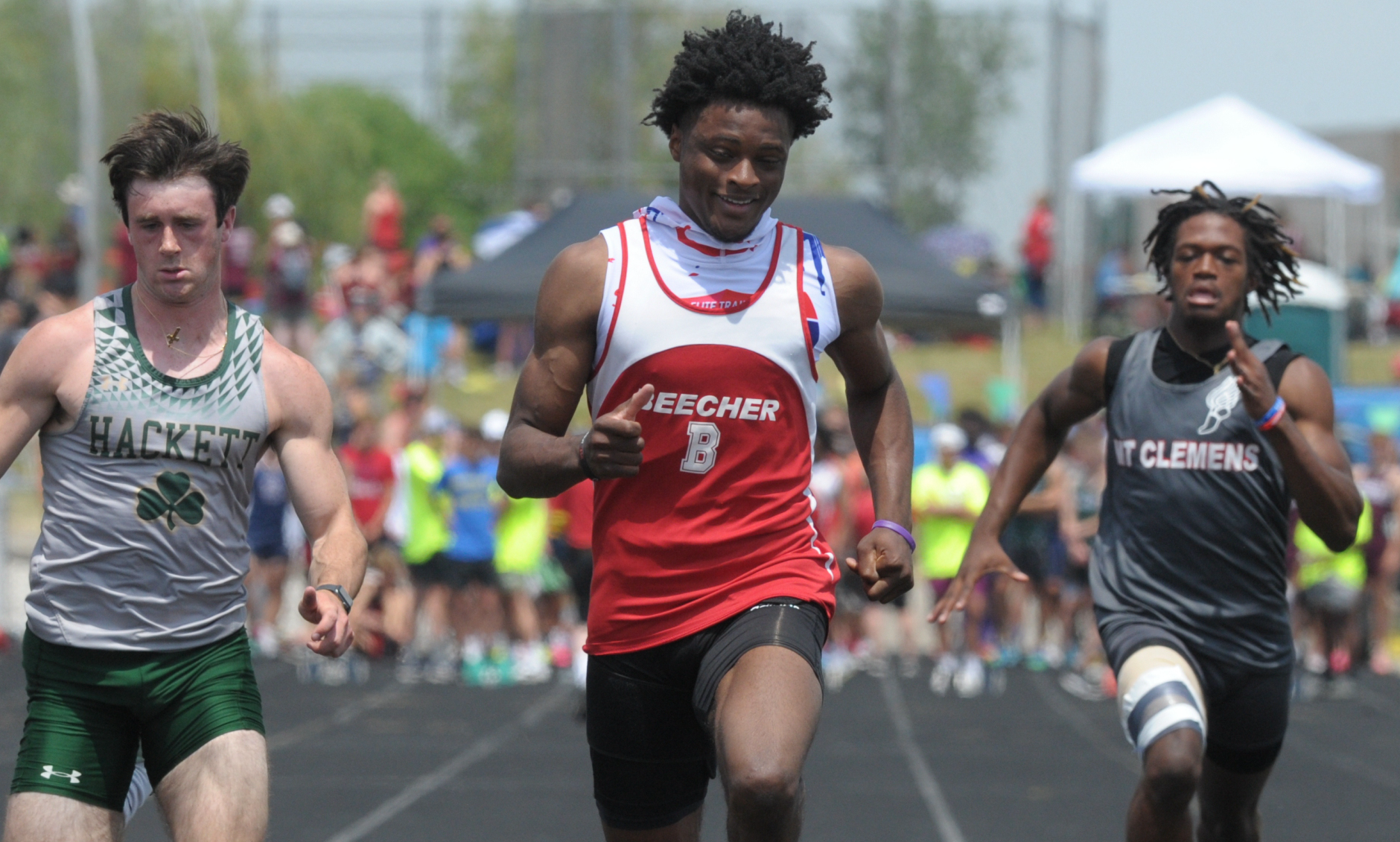 “Perseverance; I said from the beginning what I was going to do. I kept my eye on that target, and no matter the circumstances life threw at me, that I was going to make it happen and I am a man of my word.”
“Perseverance; I said from the beginning what I was going to do. I kept my eye on that target, and no matter the circumstances life threw at me, that I was going to make it happen and I am a man of my word.”
Jaylin Townsend, a senior from Flint Beecher, dominated the short races. He won the 100 dash (10.67) and 200 dash at 22 seconds flat. It was his third 100 win at a Finals.
“I put in a lot of work; I had to three-peat,” he said after the 100. “There’s a lot of great competition here, so I knew I had to come out and run my best.”
Concord in the 400 (43.72), Buckley in the 800 (1:30.76) and 1,600 (3:29.13) and Potter’s House in the 3,200 (8:14.18) were relay champs Saturday. Reading’s Tayshawn Bester won the 110 hurdles (15.13), and Athens’ Landen Bennett won the 300 (39.85). Caseville’s Nathan Feltner won the 400 (50.76), and Vestaburg’s Owen Patton claimed the 800 (1:55.11).
Fruitport Calvary Christian’s Bradley Richards won the high jump (6-10), and Peck’s Alex Affer won the long jump (23-4). McBain Northern Michigan Christian’s Isaac Bowden was first in pole vault (13-0), and Brown City’s Kyle Affer won shot put (49-2).
PHOTOS (Top) Kalamazoo Hackett Catholic Prep celebrates its third-straight LPD4 title Saturday. (Middle) Cardinal Mooney's Tyler Lenn, far right, sets the pace in the 1,600. (Below) Flint Beecher's Jaylin Townsend, middle, crosses the finish first for one of his two sprint championships. (Photos by Ken Swart/RunMichigan.com.)

